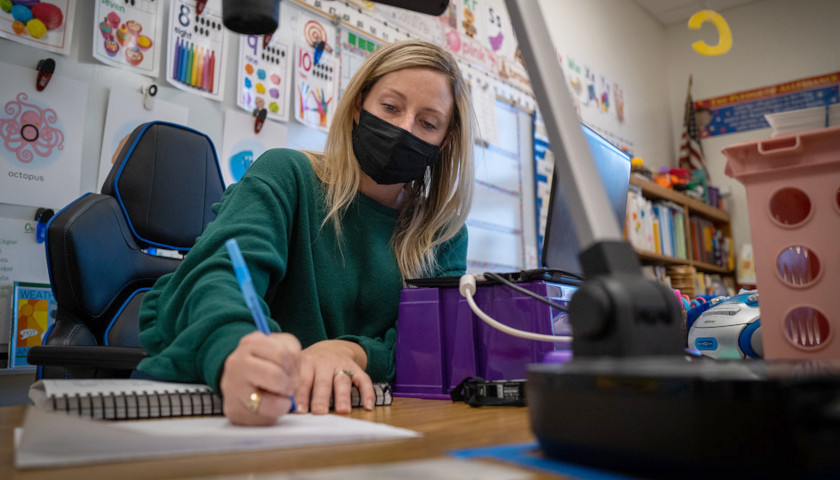by Steve Miller
As school districts across the country grapple with declining enrollments induced by the pandemic, many are engaged in spending sprees like those of the past leading to widespread layoffs and budget cuts when federal money ran out.
Bolstered by $190 billion in pandemic relief funding from Washington, the nation’s public schools are hiring new teachers and staff, raising salaries, and sweetening benefit packages. Some are buying new vehicles. Others are building theaters and sports facilities.
Using such temporary support for new staff and projects with long-term costs is setting the table for perilous “fiscal cliffs” after COVID funding expires in 2024, some education budget analysts say. And that’s on top of doubts about whether money to battle the pandemic is being properly spent in the first place.
The latest round of pandemic relief for K-12 schools – the 2021 Elementary and Secondary School Emergency Relief Fund, or ESSER – provided $122 billion to help school districts “safely reopen and sustain the safe operation of schools and address the impact of the coronavirus pandemic.”
In a January press release hailing what it called the success of the program, the Department of Education highlighted vaccination programs, tutoring, retention bonuses, and new hires. But it neglected to mention numerous other perks and frills that districts are bankrolling with that money.
Creston Community School District in Iowa used $231,000 of COVID relief to expand its sports stadium bleachers to make them compliant with the Americans With Disabilities Act.
The school board in Fort Worth, Texas, in October approved spending $171,000 of the district’s pandemic money for five vans to transport the district’s gifted and talented students.
Moore County Schools in North Carolina is already asking the county for more money after exhausting its pandemic account, which funded expenditures including the installation of two new running tracks and gym lockers.
The McAllen, Texas, school district, which has lost 15% of its enrollment since 2011, approved using relief funds for a project that critics contend is not connected to education: a $4 million expansion of a nature park on city property. That was permissible under the spending rules, so long as the state education department approved the construction project.
In an email, Texas Education Agency spokesman Frank Ward said approval of ESSER-funded construction projects “only certifies that the school system has met the minimum requirement for prior approval,” but declined to elaborate on individual projects. “Ultimately, allowable uses of ESSER funds will be determined by auditors,” Ward wrote.
Education analysts say the spending free-for-all is occurring precisely because of such murky, open-ended guidance from Washington. Each state was required to file a general spending plan for its share of ESSER funding – but not to provide specifics.
The “current wave of funding is all over the place,” said Chad Aldeman, policy director at Georgetown University’s Edunomics Lab, which conducts research on the economics of education. “There is not a clear articulation of what this money is for.”
Aldeman added that district leaders are trying to balance competing interests, making fiscal cliffs almost inevitable. “They would like to use the money to address learning loss or emotional situations with students, but their go-to strategies are adding staff,” he said. “They know in the back of their minds that it could be trouble down the line, especially with enrollment figures not looking good for a lot of districts.”
The nation’s public schools lost 3% of their students in 2020-21, compared with the prior year – much of the attrition coming as parents sought alternatives for their children in response to pandemic-related school closures.
Many districts are spending the money on projects that will carry long-term costs even as they project continued enrollment declines.
“They are now hiring teachers that they can’t pay after three years,” said Phyllis Jordan, editorial director at FutureEd, a Washington, D.C.-based think tank. “So, I do worry about [a funding cliff] happening. There are a lot of vendors with bright ideas and people will take something and be persuaded to buy something. There seems to be a lot of opportunity to waste a lot of money, but there’s also an opportunity to do something good.”
A recent RAND survey found that 40% of district leaders interviewed expected future trouble when federal aid expires. Yet few appear ready to scale down spending.
“The ultimate problem is how to spend that money without hiring a bunch of people,” said Chris Hines, deputy superintendent at the Conroe Independent School District in suburban Houston. “This is a labor-intensive industry and 90% of our budget is people.”
Conroe is growing, giving it an edge over districts saddled with falling enrollment. “But we still have to plan for what happens when that money is gone,” he said.
Recent history makes some of the new wave of spending hard to defend, and its dire consequences foreseeable. In a report meant to provide guidance for future grants, the Department of Education inspector general examined how 22 districts spent money from 2009’s $107 billion Recovery Act and Education Jobs program, enacted in the wake of the 2008 recession.
Much like today, the money was spent on hiring more staff, professional development, salaries, technology, and facilities. Half the districts used at least some of the money to add employees or expand services, aware that they were unable to pay for them once the money ran out.
Layoffs predictably began in 2016 and swept the education sector, disproportionately affecting schools in lower income areas. “Tears and disbelief” was how the Baltimore Sun described the impact of layoffs, while progressives continued to criticize state education funding as unequal and unfair.
Such reactions are unsurprising, said Michael Petrilli, president of the conservative Thomas B. Fordham Institute. He said just as with the Recovery Act spending by schools, “there will be this political dance three or four years from now, with schools saying, ‘It’s a shame putting all these people on the street.’”
Petrilli recalled that when recession relief money previously ran out, “young teachers were let go regardless of performance, class sizes rose, and high-poverty schools were the most impacted.”
And while funding cliffs were mentioned repeatedly in cautionary terms in Recovery Act education funding audits after the recession, the term is absent in today’s federal guidance for districts.
The lessons of history, and the apparent propensity of some educators to ignore them, were brought into sharp relief last June when the Council of Great City Schools, a group of 76 urban school districts, presented members with its own assessment of Recovery Act funding – a report meant as a cautionary tale that reflects today’s situation.
It found the 40 urban districts queried for the study had created 50,000 jobs at a cost of $7.2 billion from the Recovery Act funding – which breaks down to $144,000 per job (or more than twice the minimum starting pay for a public school teacher in high-cost New York City). Within two years, the council projected a deficit of nearly $4 billion and a loss of 44,000 jobs.
“This meant the Great City School districts were forced to lay off substantial numbers of teachers, counselors, coaches, substitutes, and other noninstructional positions,” the study’s authors wrote. “The result was significant beyond the loss of the jobs per se. Class sizes were substantially increased in some cities, schools, and grades.”
The council did not respond to an interview request.
Some of those member districts are already ignoring the past, spending parts of their COVID largesse on enduring costs. The Arlington Independent School District in Texas, for example, increased its annual employee health care contribution and gave across-the-board raises to teachers with six or more years of experience. The district’s enrollment has dropped 8% since 2017.
Atlanta schools, where enrollment has dropped 3% since 2015, will hire support staff to help students with their newly purchased Chromebooks and iPads. In Oakland, California, school board member Mike Hutchinson, who did not respond to an interview request, seeks to spend the windfall on libraries, more teachers, and more sports and music programs. Enrollment there is down 5% since 2017.
Some districts appear to disregard the possibility that their spending plans today will carry deep costs later. For example, switching to digital textbooks will creating ongoing licensing fees. Newly purchased vehicles will have maintenance and insurance costs. Buildings will incur heating and cooling costs and those new teachers, hired all over the country, will create legacy costs such as health insurance, benefits, and pensions.
Superintendents and district financial chiefs have to step forward and lead responsibly, Petrilli from Fordham said.
“That leadership has to say, ‘we are going to make sure this money goes to support our kids now and when the money is gone, here’s what that looks like.’ And they have to overcome the political pressure to spend it otherwise.”
– – –
Steve Miller contributes to RealClearInvestigations.
Photo “Teacher Working” by Phil Roeder. CC BY 2.0.





